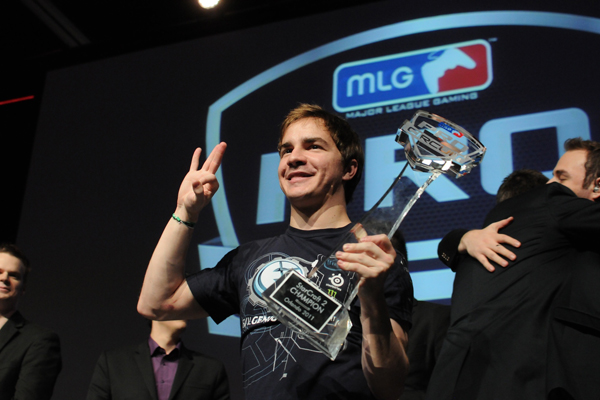Loranger, like many professional gamers, lives in a house with teammates and practices up to 10 hours a day. Life outside of StarCraft consists of a few pleasures snuck into the margins of his practice schedule: email, the gym, a movie or, in moderation, a few games of League of Legends.
“It’s dangerous to play other games, because we all have addictive personalities and are very competitive, so it’s hard to play a game and not take it seriously,” Loranger says.
For a StarCraft player, the lure of another game is a big risk. Teams, sponsored mostly by large consumer electronics companies like Acer and Intel, pay players a salary, which they supplement with revenue from personal streams and prize winnings. For a casual player, getting hooked on League of Legends while playing StarCraft II would be no big deal. For a pro gamer, it’s like a professional tennis player risking his or her career by ditching practice everyday to go play ice hockey.
Yes, pro gamers play for passion, but there is also serious money at stake. The winner of this weekend’s MLG Spring Championship will take home $25,000. Aleksandr Svusuyk, a slight 23-year-old who goes by Bly, says he can make three times as much money winning European tournaments online as he can working a normal job at home in the Ukraine.
Then there’s the fame. Just like ABC knows it will get big ratings if stars like Kobe Bryant or Lebron James are playing, Major League Gaming knows viewership will go up if fan favorites like Korean player Lim Yo-Hwan (a.k.a. BoxeR) or Dutch-born Manuel Schenkhuizen (a.k.a. Grubby) are featured in key matches.
In South Korea, where most of the game’s best players come from, you can buy a DVD of BoxeR’s greatest hits. Here in the United States you can squeeze into a crowded sports bar and watch games during regular BarCraft events. Dr. Pepper has even featured Major League Gaming players on limited-edition bottles of soda.

Major League gaming
Like in any sport, an entertaining game has to have strong players. But just like watching the Super Bowl, things can get confusing without commentary. eSports casters like Day[9] (whose brother Nick, who goes by Tasteless, is a caster in Korea) and Marcus “djWHEAT” Graham have made a career from talking about video games online. Casters tend to get their start by playing professionally, but others are aspiring broadcasters who found their niche.
The top hosts in their field talk gaming as a full-time job, working from home during the week and traveling the world broadcasting tournaments on weekends. “There have been times where I’ve traveled for eight or nine weeks in a row, going out of town every single weekend,” Plott says. “It can really mess with your sleep schedule.” Some casters, like Graham and Plott, have hired support staff to guest-host shows, manage websites and work with sponsors, which range from energy drinks to gaming hardware companies.
This week’s E3 conference marked the one-year anniversary of Twitch, a site dedicated to streaming gaming-related content that’s also the employer of many top casters. They’ve partnered with groups like Major League Gaming and the IGN Pro League to broadcast tournaments every weekend, and media companies and game developers use the service to get in touch with their own communities. Many streamers are individual users broadcasting their game play (one popular feature is speed running, with the goal of playing a game as quickly as possible without mistakes) or chatting about the video-game world. Those with a large enough following can sign up as a partner, which allows them to make money from their streams by running ads at their own convenience.
Originally a section of general-streaming site Justin.tv, Twitch exploded in popularity after its launch. It reached 17 million unique visitors last month, and growth shows no sign of slowing. And advertisers like Sprint and Microsoft want in, since eSports’ average viewer tends to be a teenager who doesn’t pick up print media or pay for cable. And they watch Twitch a lot; the average user spends 75 minutes per day on the site.
For these viewers, watching other people play video games isn’t new. “It’s the Nintendo generation growing up,” says Kevin Lin, Twitch’s chief operating officer. “My friend got the first Nintendo controller when I was in first grade. He had one controller, so I’d basically watch him play Mario.” Now that many like Lin are young adults with disposable incomes, it makes sense that they’ll tune into a pay-per-view gaming tournament.
Soon, these viewers won’t just be glued to their computers. In April, Major League Gaming and Twitch announced a partnership with CBS Interactive. Major League Gaming’s CEO, Sundance DiGiovanni, says his company was a part of CBS Interactive’s annual upfront presentation to advertisers, and there was enough sponsorship interest to start considering broadcasting live games on television.
This wouldn’t be the first attempt to broadcast eSports on American TV. In 2007, Graham worked with DirecTV on broadcasting games with the Championship Gaming Series. “It was a very big venture and a very expensive venture, and it was their attempt to try to bring the allure of gaming to television,” Graham says. But the financial crisis and a lull in competitive gaming led the show to shut down two years later. And even today, Major League Gaming produces an eSports-related talk show — that only airs internationally.
But to DiGiovanni, the timing may be right for eSports on TV. “We already do a ready-for-TV show (for online broadcasts),” he says. “We’ll maybe gussy up the sets a little bit, get a few more lights and some nice suits for everybody, but we’re pretty much ready to go.”
PHOTOS: E3 2012 Video Game Conference

